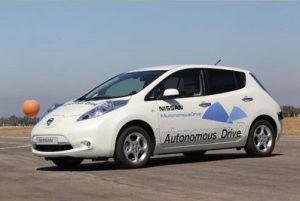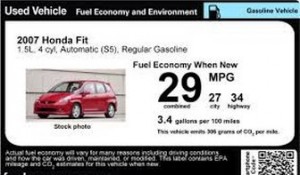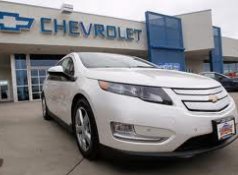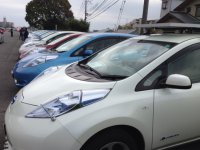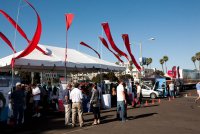 I had mixed feelings about once again attending AltCar Expo at the Santa Monica Civic Auditorium and its outside parking lot. I’ve been attending since 2009 (it started in 2006 and just completed its eight year), and it’s always been a must-attend conference – the most comprehensive ride and drive out there; excellent speaker panels with veteran experts in the field (government agencies, university research centers, automakers, infrastructure partners, consultants); display booths from automakers and organizations; and usually something very distinct you won’t forget (“Oh, I didn’t know the ports were using all-electric drayage trucks.”)
I had mixed feelings about once again attending AltCar Expo at the Santa Monica Civic Auditorium and its outside parking lot. I’ve been attending since 2009 (it started in 2006 and just completed its eight year), and it’s always been a must-attend conference – the most comprehensive ride and drive out there; excellent speaker panels with veteran experts in the field (government agencies, university research centers, automakers, infrastructure partners, consultants); display booths from automakers and organizations; and usually something very distinct you won’t forget (“Oh, I didn’t know the ports were using all-electric drayage trucks.”)
I’ve also had concerns about it. If you do a news search on AltCar Expo, you’ll see very little coverage of this significant conference. The attendance is also pretty light. I would think there would be a lot more people showing up (for example, on the fleet-focused sessions on Friday) in a city that’s considered to be a bellwether for alternative fuel vehicles and EV charging stations – not to mention that it’s one of the trendiest, wealthiest cities on the west coast. There are a lot of residents who own electric vehicles and support the basic premises behind alternative fuel vehicles – not to mention that Southern California is usually one of the leading markets where automakers first deliver green vehicles.
As for this year’s AltCar Expo, a few moments really stood out – Terry Tamminen – former head of California’s EPA during the Schwarzenegger administration when AB 32 and the Low Carbon Fuel Standard were being implemented – gave a clear picture of what’s happening in policy; Jon Coleman, fleet sustainability and technology manager for Ford’s North American Fleet, Lease and Remarketing Operations, had some very direct comments to make about the value proposition that needs to be fulfilled for EV charging and CNG refueling stations to go beyond symbolic to practical; Genze is launching an electric motorbike in the first quarter of next year that should stand out as utilitarian and hip to Millennials; and the Cal State Los Angeles EcoCAR 2 team was on hand (and so far is in second place among 15 universities in the US and Canada in this EPA and General Motors sponsored competition), displaying its converted Chevy Malibu plug-in hybrid flex fuel version. It was interesting to hear how strong sales have been since the recent introduction of Ford’s new F-150 natural gas pickup (the first half-ton CNG-powered pickup to come to market). I’ve always looked forward to attending AltCar Expo, and have always enjoyed the experience and learned a great deal about this important, new industry. I’ve just wanted to see a lot more people show up and have their own experiences with the technology.
It’s not the only green vehicle conference that faces big challenges increasing attendance, sponsorships, and other revenue to cover costs and pay for promotional campaigns – and playing a much-needed role helping to set a foundation for business growth. The Green Fleet Conference & Expo is coming up, put on by Bobit Business Media, publisher of the flagship Automotive Fleet; but there are only a limited number of people likely to attend even though it’s an excellent conference. ACT Expo is the most successful, highest attended green fleet-focused conference, and has successfully filled the void that opened up when the Alternative Fuel Vehicle Institute annual conference ended in 2010. Plug-In 2013 is coming up soon in San Diego and has been influential; the Electric Drive Transportation Association annual conference has been essential for EV stakeholders for several years; and NGV America’s annual conference is the flagship natural gas vehicle event. Still, attendance is limited at all of them, and their influence in media coverage, government policies, public opinion, and vehicle buyer decisions is slim. For those wondering what it’s going to take for green vehicle sales to increase along with all the positive environmental, energy, and economic impacts that many people are quite articulate about, I would say that successful conferences, trade shows, and vehicle displays are the meat and potatoes that need to go on tables.
Here are my thoughts on what could raise the numbers….
- Get connected with major car shows. What about moving AltCar Expo in front of the LA Auto Show? Sure, it might be competing with the Green Car of the Year award, but it’s likely that efforts could be combined – such as continuing to have the ride and drive at the Santa Monica Civic Auditorium parking space; but what about having the speaker sessions at the LA convention center during the media days or during a dedicated event promoted by the auto show? There’s going to be a very interesting connected car event at LA Auto Show in November – maybe it could have been fused together as a broader topic? Smart transportation?
- Coordinate the event with trade groups, research centers, and exhibitors. Last year, it was very productive to attend a pre-conference hosted by the Luskin Center for Innovation prior to the global EVS26 conference (put on by Electric Drive Transportation Association) at the LA convention center. It was fascinating information offered during presentations, but to a very limited audience. A much larger number attended EVS26, but once again, it was pale in comparison to many other events at that conference center. Organizations and businesses want to make gains in marketing exposure, public education, and through supporting technologies and sometimes controversial issues. I would think they should be included in the event planning process way ahead of time – and that could be one to two years out.
- Get connected with fleet managers and Clean Cities coordinators. NAFA is doing a lot of it now through its relationship with Calstart and US Dept. of Energy’s Clean Cities leadership. But fleet managers and Clean Cities coordinators are down in the trenches and bring a lot of experience and expertise to the table. Put them on your conference planning committees.
- Get celebrities to show up. Certainly, it would be tough to get big names to be placed on conference brochures – I doubt Elon Musk would be willing to be a keynote speaker; Neil Young and Willy Nelson support biofuels but are unlikely to put on a concert; T. Boone Pickens might show up and speak, but is likely to charge a hefty speaker fee; Tom Hanks was proud to drive an EV1 but would be very hard to get ahold of unless you’re a Hollywood insider. Ed Begley, Jr., is passionate about electric vehicles but might not be willing to speak at a conference in Chicago. Still, there are a lot of interesting and somewhat famous people out there who advocate and drive green vehicles – and could be convinced to come support the cause. Celebrities could include politicians, newscasters, experts (such as authors of influential books in the field), academics, actors, singers/musicians, athletes, and leaders of advocacy organizations. They might not be widely known, but could be icons to a sophisticated audience. And let’s be honest about it – we live in America, and celebrities are as big it gets. You might find that superficial, but just about every cause I can think of utilizes celebrities in their promotional campaigns whenever they can, and it tends to grab attention and conversation.
- Location, location, location – and timing. Some markets usually deliver higher attendance than others, and it’s probably best to not have these types of conferences scheduled too close together.
- Find sponsors willing to monetize the event. They’ll want a lot in return, but how unreasonable would that really be? All of the major conferences have a handful of large backers and sometimes a long list of companies willing to pay their dues to get on the list and perhaps exhibit at booths and host gala events – product unveilings, award shows, keynote speakers, etc.
- Work together with organizations looking for such an event. The automotive and transportation sectors are chock full of organizations striving to better serve their memberships. Many are chomping at the bit to host an annual conference that elevates their importance and influence and brings together key stakeholders for valuable networking and education activities.
- Make the ride and drive and vehicle displays distinct. One measure of an influential conference is the number of unveilings that happen during press conferences. There is a difference between what’s referred to by the conference planners as a product introduction and the actual launch of something. And if there’s no major unveilings to be announced, there are other ways to go – introducing a new mobile app; an upgrade to a vehicle’s features and color options; engine and powertrain enhancements; and infrastructure launches. If it’s been displayed at five conferences already, don’t claim it to be an introduction. As for ride and drives, there are ways to make it unique for that location – and user friendly for people standing in line waiting for their turn. Automakers sometimes offer incentives for car shoppers to earn when they show up at the ride and drive and go buy one of the new cars soon after.
- Get lots of media coverage before, during, and after. Some conferences are good at getting media sponsors and offering perks for them to show up and create valuable content in articles, videos, podcasts/radio, and photo galleries. Targeted trade, professional, and special interest publications are critical to draw and reach important niches, but don’t forget about mainstream media. Getting reporters from Bloomberg, Reuters, Wall Street Journal, major media from the hosting city, and business publications, is a given for the big auto shows. Getting them to show up at niche conferences is a tough sell, but it becomes more newsworthy if a governor or a championship-game-winning coach are scheduled to drive up in their plug-in cars (or hydrogen fuel cell vehicle, natural gas vehicle, propane-powered truck, biodiesel bus, or hybrid vehicle) and say great things about the cause. Blogs and social media will also play a vital role in getting the word out.
- Hold the speaker panels somewhere nearby that upgrade the professionalism and appeal of the event – such as at a nearby hotel where business conferences are popular these days.
Automakers are willing to send newly launched vehicles to car shows all over the world. They’re spending lots of money to reach eager consumers who love attending annual car shows and conferences. Green vehicles are unlikely to see anything of this size and scope, but the sales numbers are slowly inching up; and at some point, we’re going to see millions of them on the roads. To keep these vehicles running safely and efficiently, it will take a lot of people skilled and experienced in the field to be networking with and educating each other at significant industry conferences.





